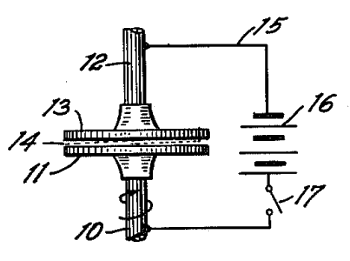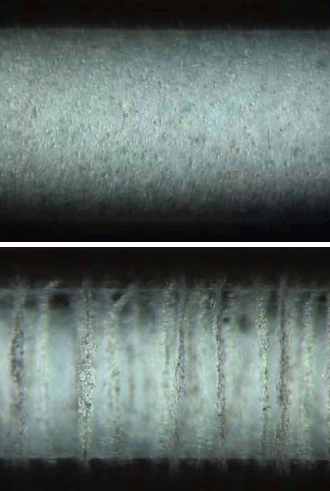Electrorheology
April 13, 2012
I've written about
rheology, the science of
fluid flow, in several previous articles (
Optical Flow, March 22, 2012,
Rheometry, November 3, 2011 and
The S-Curve, August 1, 2011). We all know that the
viscosity of fluid
condiments depends on
temperature.
Ketchup taken from a
refrigerator flows more slowly than ketchup taken from a
pantry. Many properties change with temperature, so we're not too surprised by something like this.
What is surprising is the fluid property known as
shear thickening that exists in such a simple material as
cornstarch mixed with
water. A 2:1 by
volume mixture of cornstarch in water will allow you to poke your hand into it, if you do this slowly. If you punch the mixture, it's as hard as a rock. That's because the viscosity of this
colloid increases with the rate of
shear strain. It's possible to roll the mixture into a ball with your hands, but it slumps back into a liquid when you stop working it. There are some interesting online video demonstrations.[1-2]
When an unusual property such as this is discovered, useful applications are sure to follow. One of these is
soft body armor. If such colloids can be integrated into
fabrics for
apparel, these will be flexible under ordinary human motion, but they will become hard when impacted. When
Kevlar, a common body armor material, is formulated with
silica colloids, it's about 2.5 times more effective than Kevlar alone in stopping a quarter-inch
steel ball.[3]
The cornstarch-water mixture, and similar colloids, have reversible shear thickening; that is, you can have them so their trick again, and again, and the material properties don't change from cycle to cycle. Some similar materials demonstrate
rheopexy, a time-dependent change in viscosity. If you shake them, they will thicken or solidify, sometimes returning to a liquid state only after a time.
Thixotropic materials have the reverse property, becoming less viscous and more liquid as they are shaken.
The mechanical properties of these materials are fixed by their composition, but there is another class of rheological materials for which control is achieved through application of an
electric field. These
electrorheological fluids increase their viscosity when subjected to electric field strengths of the order of a
kilovolt per
millimeter.

Figure 1 of US Patent No. 2,417,850, "Method and Means for Translating Electrical Impulses into Mechanical Force," Willis M. Winslow, March 25, 1947.
(Via Google Patents). [4)]
The electrorheological effect was discovered by Willis M. Wlnslow, who patented some applications in 1947, and published a paper in the
Journal of Applied Physics in 1949.[4-5] The basic idea is to constrain a suitable colloidal layer between closely spaced
electrodes. In Winslow's experiments, the spacing ranged from 0.1 -1.5 mm, and he was able to attain a reversible
shear resistance of several hundred
grams per
square centimeter.
Winslow noted that the colloidal particles appeared to arrange themselves into
fibers with application of the electric field.[5] An example electrorheological material can be made from our venerable cornstarch mixed with
oil.
That the particles in suspension should arrange themselves into chain-like fibers is a consequence of the
polarizability of the suspended particles. The polarized particles link together, just as
magnets would. Modern electrorheological materials exhibit a 100,000-fold increase in viscosity with a response time of a few
milliseconds. The figure below shows the particle chains produced in a mixture of
laponite particles, 18% by volume, in
silicone oil.[6] The oil takes no special role. It's just there to suspend the particles and offer
insulation against the
high voltage.

Particle chains produced by the electrorheological effect in a mixture of Laponite particles, 18% by volume, in silicone oil.
The electrodes (dark regions) are separated by 1 mm.
Top image, no field; bottom image, 2.0 kV/mm field.
(Via arXiv).[6)]
There's another class of these materials that takes advantage of the close spacing of
nanoparticles in solution. As the name implies, these
giant electrorheological (GER) materials, discovered in 2003,[7-8] show a much larger electrorheological effect, often ten times greater. The first GER material was formed from nanoparticles of
urea-coated
barium titanyl oxalate.
The nanoparticles were 50-70
nm in diameter with a 3-10 nm coating of urea, a compound with a large electric dipole moment. A static yield stress of 130
kPa was obtained for a field strength of 5 kV/mm. The effect was observed in a temperature range of 10–120
°C, with a reversible response time of <10 msec.[7-8]
The mechanism for the enhancement is that the
polar urea molecules provide hundreds of times local field enhancement between particles. As can be expected, there's been considerable research on these GER materials.[9-11] In another example,
strontium titanyl oxalate in silicone oil provided a yield stress of 200kPa at 5kV/mm.[9] Such large yield stresses allow application of such materials in electrically-controlled
dampers,
clutches and
valves.[8]
Combining effects can lead to better materials. Winslow, himself, made electrorheological materials of
ferrite powders that responded to both electric and
magnetic fields,[5] and there's been other work in this area. Having magnetic particles allows the use of magnets to prevent particle
sedimentation in electrorheological fluids.[12]
References:
- Walking on Non-Newtonian Cornflour, YouTube Video, December 31, 2007.
- Non-Newtonian Fluid on a Speaker Cone, YouTube Video, November 26, 2008.
- Norman J. Wagner and John F. Brady, "Shear thickening in colloidal dispersions," Physics Today, vol. 62, no. 10 (October, 2009), pp. 27-32; PDF file available, here.
- Willis M. Winslow, "Method and Means for Translating Electrical Impulses into Mechanical Force," US Patent No. 2,417,850, March 25, 1947.
- Willis M. Winslow, "Induced fibration of suspensions," Journal of Applied Physics, vol. 20, no. 12 (December 1, 1949), pp. 1137-1140.
- K. P. S. Parmar, Y. Meheust and J. O. Fossum, "Electrorheological suspensions of laponite in oil: rheometry studies under steady shear," arXiv Preprint Server, September 19, 2006.
- Weijia Wen, Xianxiang Huang, Shihe Yang, Kunquan Lu and Ping Sheng, "The giant electrorheological effect in suspensions of nanoparticles," Nature Materials, vol. 2, no. 11 (November 2003), pp. 727-730.
- Liz Kalaugher, "Nanoparticles go against the flow in electrorheology breakthrough," nanotechweb, October 8, 2003.
- Carlos S. Orellana, Jinbo He and Heinrich M. Jaeger, "Electrorheological response of dense strontium titanyl oxalate suspensions," Soft Matter, 2011, vol. 7, no. 18 (2011), pp. 8023-8029; PDF file available, here.
- Shuyu Chen, Xianxiang Huang, Nico F. A. van der Vegt, Weijia Wen and and Ping Sheng, "Giant Electrorheological Effect: A Microscopic Mechanism," Phys. Rev. Lett., vol. 105, no. 4 (July 23, 2010), Document No. 046001 (4 pages).
- Thomas C. Halsey, "Electrorheological Fluids," Science, vol. 258 no. 5083 (October 30, 1992), pp.761-766.
- Weijia Wen, Ning Wang, Wing Yim Tam and Ping Sheng, "Magnetic materials-based electrorheological fluids," Appl. Phys. Lett., vol. 71, no. 17 (October 27, 1997), pp. 2529-2531; PDF file available, here.
- James E. Martin, Judy Odinek, Thomas C. Halsey and Randall Kamien "Structure and dynamics of electrorheological fluids," Physical Review E, vol. 57, no. 1 (January 1998), pp. 756-775; PDF file available, here.
- U.Dassanayake, S.Fraden and A. van Blaaderen, "Structure of Electrorheological Fluids," arXiv Preprint Server, January 26, 2000.
Permanent Link to this article
Linked Keywords: Rheology; fluid flow; condiment; ketchup; refrigerator; pantry; viscosity; temperature; shear thickening; cornstarch; water; volume; colloid; shear strain; ballistic vest; soft body armor; textile; fabric; apparel; Kevlar; silica; steel; rheopexy; thixotropic material; electric field; electrorheological fluid; kilovolt; millimeter; Google Patents; Journal of Applied Physics; electrode; shear resistance; gram-force; square centimeter; fiber; oil; polarizability; magnet; millisecond; Laponite; silicone oil; insulation; high voltage; arXiv; nanoparticle; giant electrorheological material; GER; urea; barium; titanyl; oxalate; nanometer; nm; kPa; Celsius; °C; chemical polarity; polar; strontium; damper; clutch; valve; ferrite; magnetic field; sedimentation; US Patent No. 2,417,850.